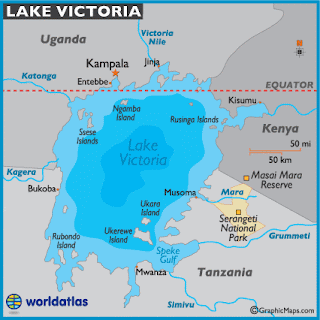Africa is known for its incredible lakes, however Lake Victoria is the most famous. Named after Queen Victoria herself by John Speke himself in 1858. Also known as Victoria Nyanza this is the largest lake in Africa (about the size of Ireland), with an area of around 26,828 square mile (Its coastline exceeds 2,000 miles)! Lake Victoria is the largest tropical lake in the world and there is only one freshwater lake in the world that is bigger and that is Lake Superior in North America.
Due to the size of the lake it is part of different East African countries. It sits mainly in Tanzania but also Kenya and Uganda. (See below)
Being the main reservoir of the Nile it is filled with wildlife such as around 200 species of fish (like the Tilapia). Lake Victoria has very clear water and if you look just below the surface you will see an abundance of reefs and archipelagos. Within Lake Victoria there are around 84 islands known as the Ssese Group. These attract a high amount of tourists due to the beautiful views and the exotic wildlife.
Scientific studies have shown that in the past the lake has dried up completely. This could be due to the fact that approximately 80% of the lakes water comes from rain.
In 1996 (May 21st) a ferry known as the MV Bukoba sake in Lake Victoria. Around 1,000 people died in the accident making it one of the worst maritime disasters in Africa's history.
The lake is surrounded by many towns who use the lake as a dumping ground for sewage every day. Along with farm waste this is causing the lake to become very polluted. Another issue is a plant called Water Hyacinth. This plant is not native to Africa and was brought across from Europe. It is a fast growing plant and over the years has started to cover large parts of the lake blocking sunlight for life below the surface. Scientists worry that soon these issues could cause all life in the lake to go forever.
Above shows a photograph of a lake covered in water hyacinth.
Lake Victoria is stunning and definitely somewhere to visit on your trip to East Africa.





